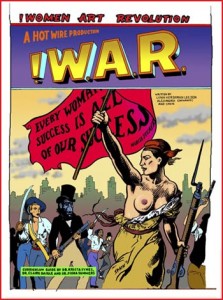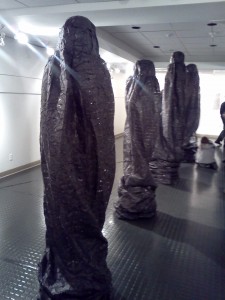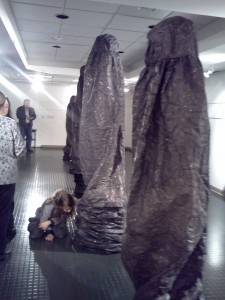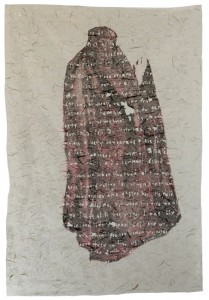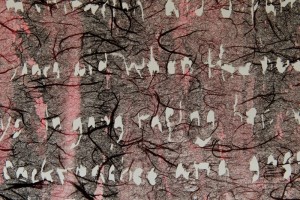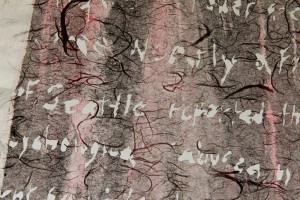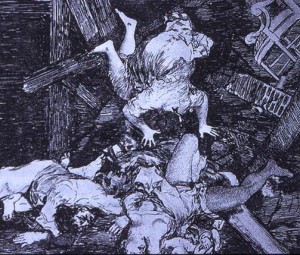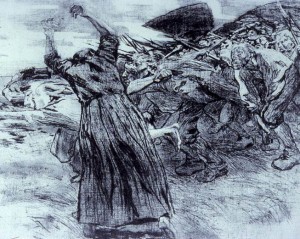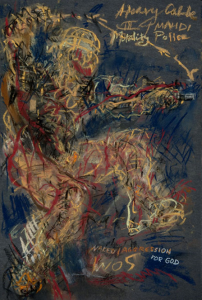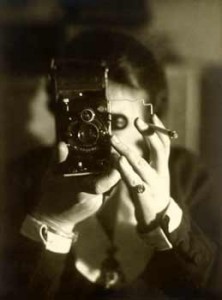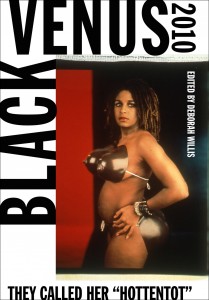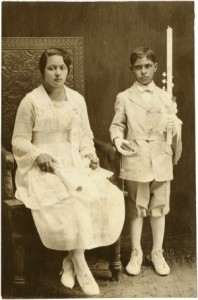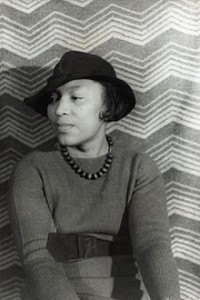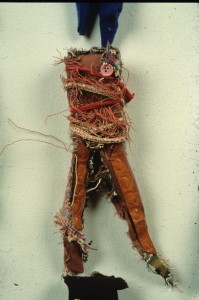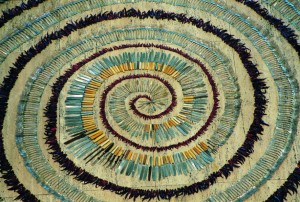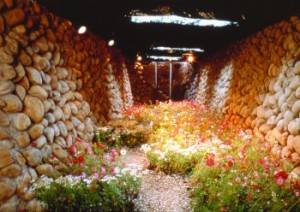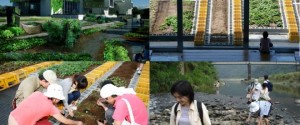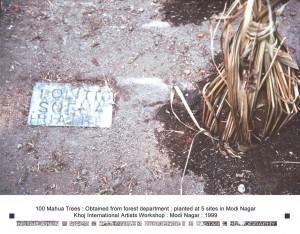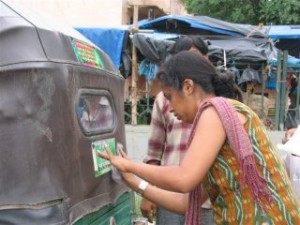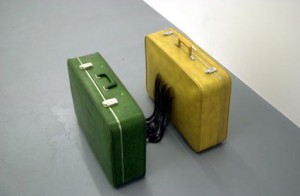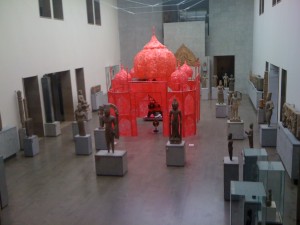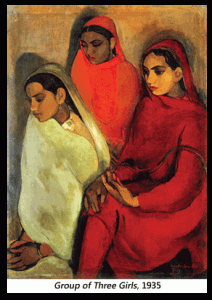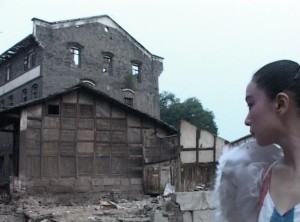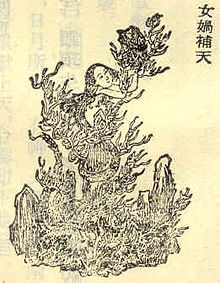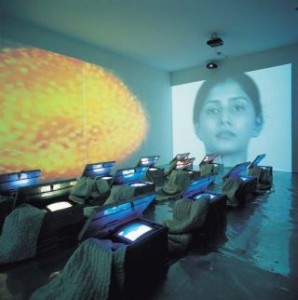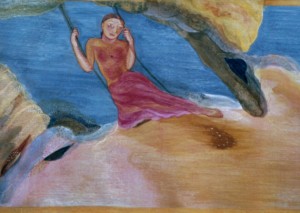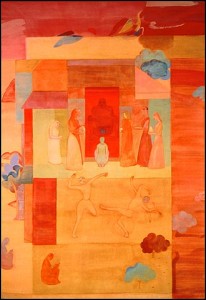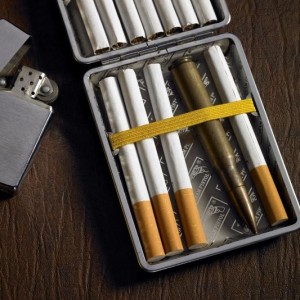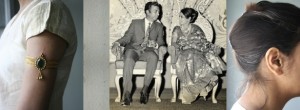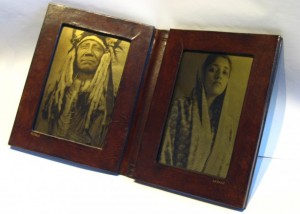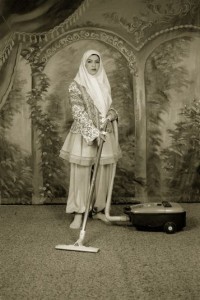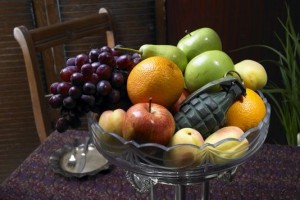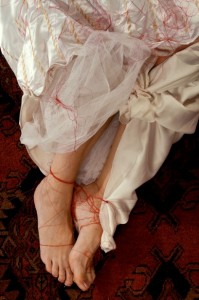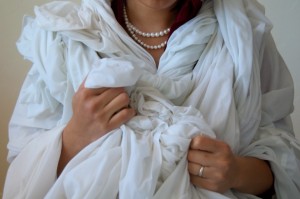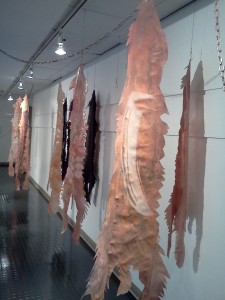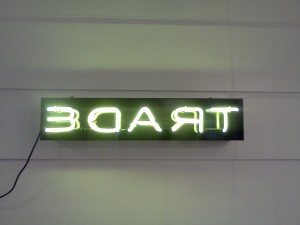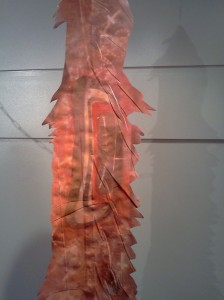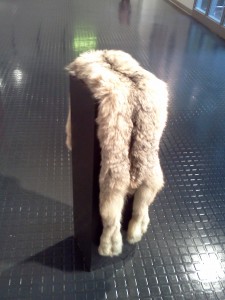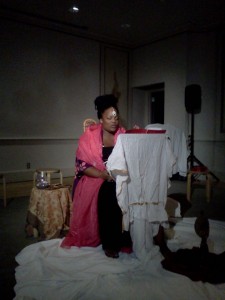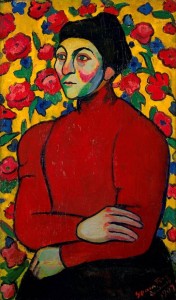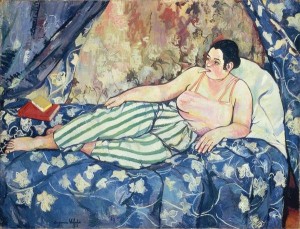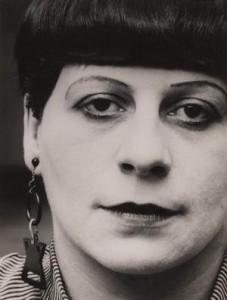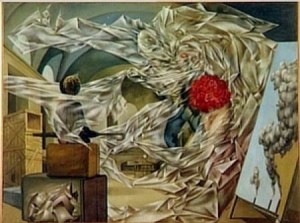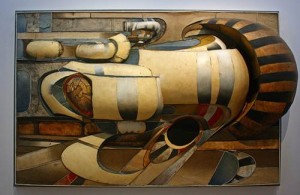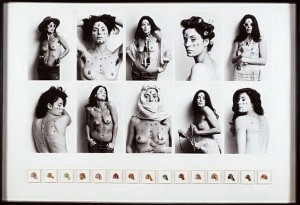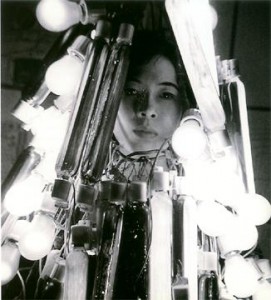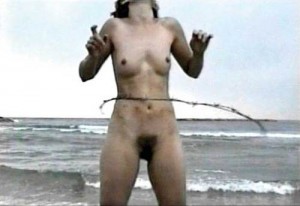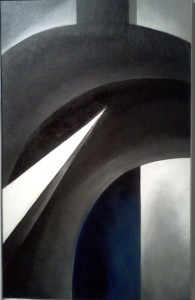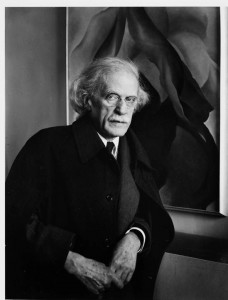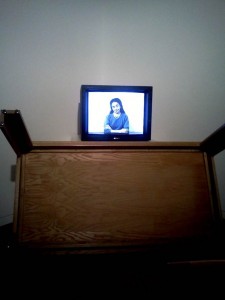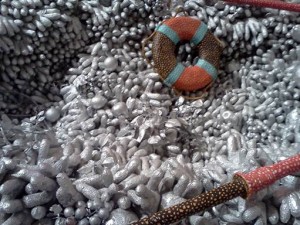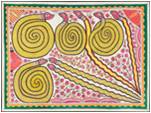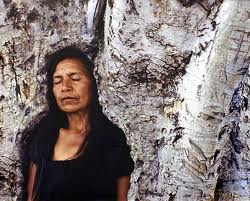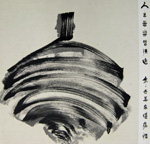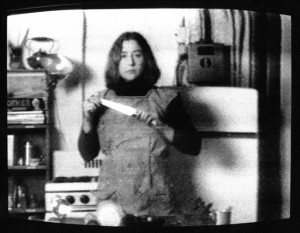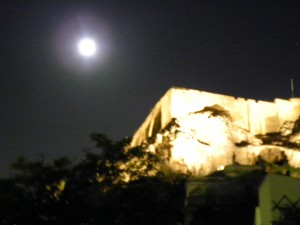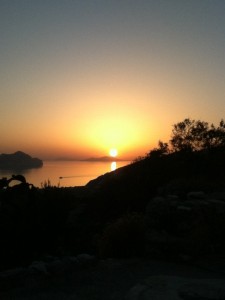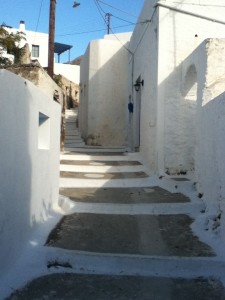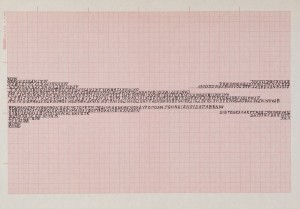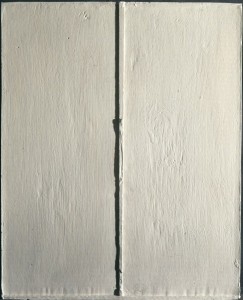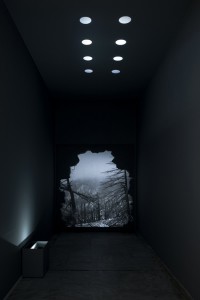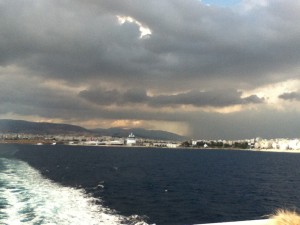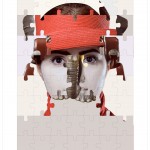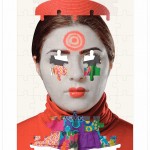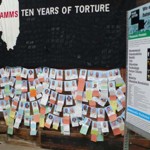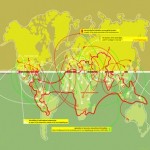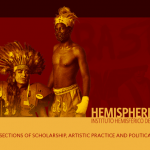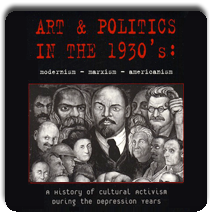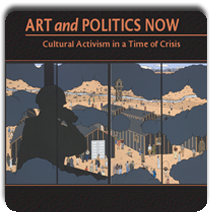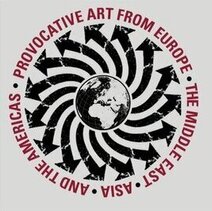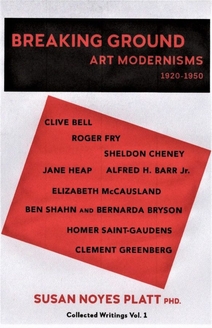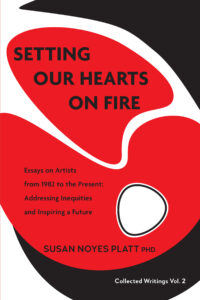Lynn Hershmann Leeson !Women Art Revolution The Movie
The Film “!Women Art Revolution” by Lynn Hershmann Leeson is an impressive work. (the image above by Spain Rodriguez is from a graphic novel based on the film). We all know the story of course, of the feminist art movement, but Leeson has collaged earlier and later interviews with benchmark artists, dramatic timelines graphically represented and vintage footage. It has a good pace and we are caught up in the drama of the story of women who turned the art world upside down from the 1970s to the 1990s.
Of course, this is an artist’s perspective. There was no reference to Linda Nochlin’s famous essay that started feminism in art history “why have there been no great women artists” and the affiliated exhibitions.
Leeson included two critics substantively, Arlene Raven (although not as a critic’s voice, but her personal story), and Ruby Rich, film critic. Moira Roth appeared briefly, and Lucy Lippard even more briefly, a critic whom I consider the most important of the era.
Curators were better represented with Marcia Tucker humorously telling her own very important story. The main story though is the usual history of US feminism, Starting with Judy Chicago in 1971 with a workshop in Fresno going through the Cal Arts Program, Woman House, Woman’s Building 1975, and from 1985 the Guerrilla Girls, who are a separate and crucial story.
This is the enshrined history of feminist art in the US. All the interviews are available online.
So, what about all the other stories?
There was a brief interview with the ever fabulous Faith Ringgold, but bell hooks was absent. bell hooks articulately explained why feminism in general and feminism in the art world, in particular, excluded women of color or to be more succinct, was racist. Other artists of color included were Howardena Pindell and Adrian PIper, and briefly Lowery Stokes Sims. All very articulate, as well as prestigious.
Judy Baca managed to mention the important fact of the vast gulf between feminism and her community based work with youth at risk.
Martha Wilson, founder of Franklin Furnace, provided a refreshing dissent from the narrative line, and of course Martha Rosler is always about more than meets the eye.
A friend of mine said to me. “Why weren’t you included?” It tells us a lot about how history is constructed for me to answer that question, which is only my own particular place in these decades. But so many people have related reasons for not being part of history.
First, I was from NYC and my mother did not do housewife stuff. So I didn’t have a model, or a suburban life style to rebel against which was a reference point not only for some of the artists, but also the content of their work.
Second, at the time of the eruption of feminism in the early 70s, the famous California stories, I was first in Boston, then Houston Texas, then Austin Texas. I had no catalytic community of feminists.
Third, I admit it, I was a conservative then. I did get involved with anti war protests in Boston, but feminism and especially feminism in the art world was not a compelling concern of mine.
Fourth, I became excited about feminism ( in general, not art world concerns) when I saw the Dinner Party in, of all place, Clear Lake City Texas, ( where NASA is located) in 1979. I was at that time critic for Artforum for the state of Texas, so I drove the four hours there from Austin to see it ( of course Artforum wasn’t interested in 1977)
Fifth, I was raising a child alone and working full time.
Sixth, when I held a teaching job at Mills College I was immersed in feminism, but my best friends were philosophers, not artists.
Seventh, by the early 80s I was even more geographically challenged, teaching at remotely located Washington State University in Eastern Washington.
Eighth, in the 1990s I moved back to Texas and did get involved with the Women’s Caucus for Art (not mentioned in the film!). At that time the board was dominated by artists of color, so my real introduction to feminist art was among women artists of color who were addressing intensely social issues.
That is still my interest today. Not simply women getting shown and sold, which was what mostly concerned the feminist artists in the film, but with women artists and all artists who represent social issues.
So I am not part of this enshrined history of feminist art, and neither are any of the powerful women I met in the WCA, all of whom are well known aritsts: Flo Wong, Imna Arroyo, Gail Tremblay, Clarissa Sligh, Yong Soon Min and many more.
And then there is the global component, and feminism outside the US! I went global in 1995 when I went to the NGO women’s conference in Hairou China with the WCA. We met amazing women changing the world from the ground up. It was overwhelming. I was also the lone representative of the International Association of Art Critics to the conference, but art criticism wasn’t ready for global feminism. I only did a short article in thier newsletter.
So the movie is described as exploring “the relationship between feminist art and the 1960s antiwar and civil rights movements and shows how historical events sparked feminist actions against major cultural institutions.”
This is a little misleading. What was the relationship of these privileged art students to Civil Rights – they were almost all white! The real relationship was the idea of activism itself, the changing of the climate in the world to the idea of collective activism. And since these women were in the “art world” that is where their activism played out.
We need another history of feminism and art in the US that begins with real world community activism and women of color who bravely spoke out about poverty, jails, drugs, domestic violence. It is out there.
Rape is a part of many of these artists stories, (emphasized only in Suzanne Lacy’s amazing work which she continues to this day) .
Perhaps that needs to be brought onto center stage.The History of Feminist Art About Rape (see my previous blog).
This entry was posted on January 16, 2013 and is filed under Feminism, Feminism, Uncategorized, Women Artists.
Tatiana Garmendia Takes on Topic of Violence Against Women in “Veils of Ignorance”
As we were standing in the opening of the exhibition “Veils of Ignorance”, just days after a young woman had died as the victim of gang rape in India, and that country was experiencing a nationwide protest, Tatiana Garmendia stated “this exhibition could have opened any day, and there would have been an example of rape, domestic violence, or abuse of women.”
Garmendia spent many months researching domestic violence. She collected statistics from all over the world as well as narratives and poetry. The cumulative effect is overwhelming, but it is essential that we all experience this show. It is so easy to be in denial about the reality of the conditions of women today. So many artists avoid these realities in their work. Garmendia has faced them.
Her motivation is based on a childhood experience she had in Cuba
“When my nuclear family was punished by Castro’s government and sent to La Trampa, a camp for political dissidents, I witnessed acts of unspeakable violence. Most of my memories of that time are blocked, but one memory has always remained. At the age of six I was forced to watch as Marilyn, an eight year old girl, was gang raped, had her mouth and panties stuffed with cockroaches and threatened with death if she ever told. Marilyn never spoke again. Not one word.”
Bravely, Tatiana Garmendia has both shared this traumatic experience and created a deeply affecting exhibition that calls our attention to the situation of abuse for women and girls locally and globally.
Towering figures wrapped in black (they are actually about 16 feet tall, but are shortened because of the gallery ceiling height.) Their coverings which intentionally evoke the intense coverings of the most conservative Muslim women only even more so, as there is no face showing at all, are pierced by words that have been burned into the paper. Her reasoning behind referring to these “Unryu burqas “ is that it becomes a surrogate for battered women everywhere. As the artist states “I came across a statement by an Islamic feminist, ‘All women everywhere wear the burqa.’ I understood this to mean that the veil is but an outward symbol of a much more pervasive reality of oppression, one that is global and not just regional.”
Some covered women might disagree with that idea as they might have covered themselves out of piety or modesty, but the general idea of covering women comes out of a conservative rural interpretation of the threat that women pose to men (actually, it was a Byzantine tradition before it was taken up by Muslims later, in Mohammed’s time women were not covered in this way). In fact, as this exhibition makes absolutely clear, the threat is much more of men toward women.
The words the artist has burned into the paper veils and the ” flags” at the end of the gallery as well, are testimonials by women who are victims of domestic violence. The artist told me that she burned them into the paper in response to her horror that women actually burned themselves to death in order to get out of impossible domestic situations. The burned words are personal stories.
The second component of the exhibition is an audio tape which recites first hand stories and poems, alternating with worldwide statistics on the huge rates of violent attacks on women and girls. These attacks include domestic violence, trafficking, prostitution, dowry deaths, women in the military, rape and sex selected abortions and more.
The cumulative effect is overwhelming. It is enraging. The numbers are unbelievable from around the world. For example
3 women a day are murdered by husbands and boyfriends
Every 15 seconds a woman is beaten
Around the world, 1 in 3 women is beaten, coerced into sex or otherwise abused by a member of her own family
Every 9 seconds a woman is raped
In 2012 in India a dowry death occurred every 90 minutes
50,000 women are trafficked each year
2 million children forced into prostitution every year
But the installation also includes resistance:
Beware
out of the ash I rise with my red hair
and I eat men like air
And it ends on a note of hope
“We embody the power of courage, endurance of strength
the beauty of survival”
I could not help but think of the SHARE/WHEEL women who wrote the poetry in the anthology Beloved Community The Sisterhood of Homeless Women in Community. Their stories and poetry are often of a life that begins in domestic violence, but these women have survived, they are living examples of the strength of women to overcome the nightmare of personal intimate violence.
Another Seattle production was the Yoni Ki Baat monologues by South Asian Women many of which spoke of early violence in their lives.
API Chaya is an organization that helps specifically South Asian Women. It “seeks to end systematic violence in our community.”
And of course there are many more connections that could be made locally.
By the way apparently the men who raped the woman who died in India blamed the victim. See the link at start of post.
Exhibition Info: M. Rosetta Hunter Gallery ( Seattle Central Community College) until January 31. Hours 9:30 – 3:30 Mon to Fri 5-7PM Wed and Thurs evenings Phone 206 934 4379
This entry was posted on January 11, 2013 and is filed under CARA, Chaya, Seattle Art, violence against women, Women Artists.
My imaginary interview with Amy Goodman on Culture and Resistance
Amy Goodman featured “Culture and Resistance” today.
I love Democracy Now and I love Amy Goodman, but this show was notable for what was not included: visual artists!
In my opinion it also reflected an East Coast bias, in omitting the voices of Latinos, Asians Americans, Indigenous artists in any media.
Now Amy is great on covering issues across the whole spectrum of the US, so it is odd that for this show she omitted so many possible perspectives on “Culture and Resistance.”
I started to imagine Amy Goodman interviewing me. My fantasy interview
AG Tell us why visual artists are so important in resistance.
SNP Visual artists make visible the invisible. All of the artists that I write about give us insights that they have gained through their lives, their experiences and their obsessions about injustice in the world. They bring a highly attuned aesthetic sense to shape their images in such a way as to make that injustice penetrate into our souls
AG How did you decide which artists to include in your book “Art and Politics Now, Cultural Activism in a Time of Crisis”?
SNP I followed the issues and grouped artists according to those concerns, such as Resisting Police States, Women, War and Imperialism, Exposing Racism, Crossing Borders, Ecology. I often had a few artists in mind whose work I had followed for many years, then I would add other artists as they emerged during the years I was writing the book . I began the book just after 9/11 and continued to work on it until 2010, It was going to press during the BP Gulf Oil Spill. I include artists of many different perspectives, but I tried not to ghettoize ethnicity, but focus on the issues addressed, which are frequenly shared by everyone.
AG You dedicated your book to Selma Waldman. Tell us about her.
SNP Selma Waldman died in 2008 as I was finishing the book. She was absolutely committed in her art to making injustice visual as well as to honoring those who helped to do that.
Selma grew up in Kingsville, Texas, as the daughter of the only Jewish family in that city, and going to school with many farmworkers children. She learned early about injustice. In 1960 she went to Berlin on a Fulbright Fellowship and saw the movie “Mein Kampf” as well as the front page stories about the massacres in Sharpesville, South Africa that year.
She decided to dedicate her art to addressing injustice, beginning with the “falling man” based on photographs of holocaust victims. For many years her work addressed apartheid in South Africa and other Civil Rights issues around the world. She always had a global perspective on injustice. In her last months she completed 180 chalk drawings on black notebook paper of specific examples of torture at Guantanamo and Abu Ghraib. She called the series, “Black Book of Aggressors” Right before she died she planned another series based on Goya’s “Saturn Devouring His Children,” in which she referred to war devouring people in conflicts all over the globe. Her work is in the grand tradition of Goya and Kathe Kollwitz, two artists who unflinchingly represented the horrors of war.
AG In your book, “Art and Politics Now” you include other artists who represented Abu Ghraib torture.
SNP Yes. There are several, and of course they only represent a sample. I chose two others Fernando Botero and Daniel Heyman. The revelations via the internet, 60 minutes, and Stuart Hirsch’s article in the New Yorker came out in 2004. Colombian artist Fernando Botero made a series of paintings and drawings that translated the raw photographsas well as other sources into paintings in his characteristic inflated bodies. He declared he wanted to give the prisoners moral weight that made them heroic. Botero is best known for painting happy bourgeois small town people, but he has frequently addressed injustice such as the military junta in Columbia, and the drug cartels. That aspect of his career is not as well known.
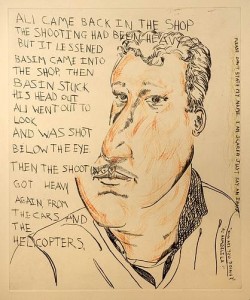
Another artist in the book representing Abu Ghraib, Daniel Heyman,
is not as well known internationally.
He accompanied a team of lawyers who were preparing a class action lawsuit against two corporate contractors who provided Abu Ghraib with interrogators and translators. Heyman’s portraits give us men who had been released from Abu Ghraib, often disabled. He sat in on interviews in Istanbul, Turkey, and not only drew portraits but also recorded the words of the released prisoners, none of whom had ever been accused of a crime. Only this week that lawsuit was successful! The 71 released prisoners won over 5 million dollars from military contractors who organized the abuse. There is also a second suit pending.
AG We are just about out of time. What would you like to leave us with?
SNP Artists who make visual the pressing concerns of the world have a deep commitment to justice. They work in many different styles and media of art. Usually, these artists have chosen to represent injustice in spite of their art school training, which usually encourages artists to create aesthetic objects with technical sophistication, objects that represent only the artist’s personal identity and can be sold on a capitalist art market. Many of the artists I write about are also successful in selling their work (some choose not to sell it), but that is not as important to them as the fact of raising their voices against injustice.
Last, I would like to say that this is not new in American art. During the 1930s artists were also deeply committed to representing injustice, a story that I tell in my previous book, Art and Politics in the 1930s. These contemporary artists work in a tradition that is powerful, but that is generally suppressed in the media and in art history and art criticism. I write about these artists ( also on my blog of the same name) in order to increase understanding of the issues they represent and how these extraordinary artists have contributed to that understanding.
AG Thank you Susan Noyes Platt. We will continue this conversation soon!
This entry was posted on January 1, 2013 and is filed under Art and Activism, Art and Politics Now, art criticism, Art in War, Art of Democracy.
Constructing Black History: The Present and the Absent
Dr. Deborah Willis, Chair and Professor of Photography and Imaging at Tisch School of the Arts, New York University, spoke to a packed and enthusiastic audience at the Seattle Art Museum on December 14 on the roles of “race, representation and gender” within works of art. Dr. Willis spoke about a few of the works featured in “Elles: Women Artists from the Centre Pompidou, Paris” but she also integrated the show, with an emphasis on representations of and by African American women.
The general theme was that the display of the female body reflects how we interpret the world.
She deftly began with a reference to Germaine Krull’s amazing 1925 Self Portrait holding a camera and smoking a cigarette, reflected in a mirror. This portrait tells us so much about the new women who were subjects rather than objects in the early 20th century.
Next, she went back to the mid 19th century images of the “Hottentat Venus,” about which she has edited a book Black Venus 2010: They Called her Hottentat .
Moving forward from there, she showed an amazing runaway slave advertisement with a carte de visite (!!) image of a slave, cut in half. Certainly a carte de visite of a slave suggests a concubine relationship with a master who would have the money to commission this “visiting card” an irony for a slave, to say the least. Cutting it suggests the attack of the master on the woman who refused to submit her life to him. I got many insights into that slave/concubine relationship in Isabel Allende’s Island Beneath the Sea in which the main character is enslaved to a man who forces sex on her from the time of her adolescence.
From the early 20th century, we saw Florestine Collins as a black photographer from New Orleans who had a flourishing career for decades. Carl Van Vechten’s famous portrait of Zora Neale Hurston, the famous anthropologist, is an intimate image of an incredibly important woman.
Willis then moved on to the theme of “women who love their bodies” like movie stars, and women photographers such as Dora Maar, liberated by new mores and new equipment. Of course Germaine Krull is one of those.
She concluded with various recent women photographers represented in the show and Carrie Mae Weems, who should have been included!
The only African Americans on exhibit in SAM’s current shows are Adrian Piper and Lorna Simpson.
Marita Dingus is on permanent display in the African galleries with her amazing 400 men and 200 women of African descent. ( this is a detail of one figure).
For another perspective go to the Northwest African African American Museum to see the beautiful exhibition by Carletta Carrington Wilson “book of the bound.”
The museum has opened a new gallery with a wonderful intimate scale for this special exhibition which continues until March 10. Carrington Wilson is a poet and spoken word performer as well as a visual artist. In this exhibition she has given us 22 books, many of them bound shut, with ornate covers of many materials, bone, lace, newspaper, fabrics, string, jewels and much more.
The theme of the exhibition is that slaves were silenced, their narratives lost.
Carrington Wilson uses fabric as the means of suggesting the connection of trade, money and the “thread-bare body”: the wealth of the traders was based on the bodies of the slaves. As the artist explains in the brochure of the exhibition:
“Three vessels, the body, the book, and the ship form an intimate connection in the works of “book of the bound.” My work attempts to enter into mysteries binding bodies of flesh to the bodies of land, water, and text that forged and formed the social fabric of our hunger-haunted history”
Her collaged covers become a song to those who could not fill these books with their stories. In some cases the books are opened in a series of pages, accordion pleated, standing, or other formats. We see references to those who would have been in those pages. Each book has a poetic title, and often also a poem.
But the significance of the use of fabrics is profound. The wall label explains the relationship of cloth and slave further:
“The essence of the ship, the book and the body is held in the cloth of the collages. Merchants could not have sailed these ships to Africa without canvas sails. Because European slavers often traded fine fabrics like silk and velvet in exchange for bodies, Wilson believes the stories of their bodies remain in the cloth.”
Carrington Wilson also includes stacks of books whose titles create found poetry. We are invited to do the same thing. This seemingly serendipitous project is revealing. The opportunity for us to create found poetry that points toward issues of the slave trade is empowering.
To view Carletta Carrington Wilson’s artwork see her website
Don’t miss Carletta Carrington Wilson speaking about the exhibition on January 10, 2012 7-9PM at the Northwest African American Museum
This entry was posted on December 27, 2012 and is filed under Arican American history, Women Artists.
“New Geographies of Feminist Art: China, Asia+the World” A Symposium in Seattle
“New Geographies of Feminist Art: China, Asia+the World: A Symposium” at the University of Washington gave us an opportunity to think about feminism today and how it can be redefined by new realities. The feminist movement in the US re-emerged in the late 1960s and 1970s as a part of the many resistance movements of those years that built on the Civil Rights legislations of the 1950s and 1960s. Some of the primary campaigns were on equal pay and equal access to health care and birth control (issues that are still with us). In the art world, misogyny, racism, and elitism, became a focus. Looking back at that art (as we could do this fall in Seattle in the “Elles” exhibition), we see women asserting themselves mainly with their bodies: Hanne Wilke amusingly undresses in front of Duchamp’s “Bride Stripped Bare By her Bachelors Even.” But elite and beautiful female artists undressing seems dated and pointless today. ( Wilke’s later work as she was dying of breast cancer is more resonant today)
Issues for women’s bodies, such as-again with reference to the Elles exhibition-Tania Brughuera’s painful manipulation of her mouth as a metaphor of the difficulties of speaking out–point more directly to present concerns.
Today women artists are reaching out beyond “art world” issues, and “body” issues, to address what is actually happening in terms of our planet and its people. Feminism in art today is embedded in cultural and geographical differences.
That is the premise of the conference “New Geographies of Feminist Art: China Asia+the World” organized collaboratively by Art Historian Sonal Khullar and Sasha Welland, Gender, Women and Sexuality Studies Professor. The symposium offered an impressive array of brilliant, predominately young, Asian, female scholars and curators, as well as three well-known artists, Navjot (who came from Mumbai), Wu Mali based in Taiwan, and Hung Liu, formerly of China, now in California, and a professor at Mills College.
The keynote address was given by Shu-mei Shih, Professor of Asian Languages and Cultures, Comparative Literature and Asian American Studies, at UCLA. Her main theme was “interconnectiveness” – “minor” sites are as important as “major” sites. She declared that feminism was an “ethical position” rather than simply a depiction of victim hood.
As examples she talked about several performance artists who address feminism as an action, and a method, but not as content. In other words, art about the female body is being replaced by metaphors that have a broader significance.
The clearest example was the work of Wu Mali. While her earlier work is specifically about women’s stories and aesthetics, of which a wonderful example, Secret Garden, was featured on the symposium website,( see above) and her current work is a community-based practice addressing environmental issues ( second image above). she declares that
“Despite the various subjects, I am really dealing with only one core issue in my works: how does a person exist comfortably in an environment? Although a straight-forward question, this has never been a simple affair. For example, coming from a gender perspective one faces gender issues, in urban development one encounters class issues and the relationships between a nation’s power and its citizens. These matters are entangled with many complicated issues, but all derive from the question of how does one go about settling in his or her environment? How does a person live happily in despite of one’s identity, gender, background, or social class? If you look at things from these perspectives you’ll find many problems; when a person faces their surrounding, it is a land issue as well as an institutional issue.”
Another artist who was featured at the symposium, Navjot, moves easily between the realms of abstract theory and concrete collaborations with indigenous people and street children. Her position is that “the artist does not solve problems, only raises questions.” One question she raised was “why do people migrate,” as she observed how impoverished life was in the shanty towns of the city compared to village life. Navjot, like Wu Mali, has many strategies and themes in her work, and she collaborates with artists and the general public.
She is deeply concerned about ecological issues such as water pollution and the privatization of water. Her concern is to encourage creative thinking rather than to follow a preordained idea. She believes that something as simple as providing children with a place to play is a step toward a future society that is not wracked by violence. She also works with the public in urban areas, a much more unusual practice in India than in the United States.
Sonal Khullar, one of the symposium organizers, in her all-to-brief introductory remarks, spoke of migration and incarceration in relationship to historical violence (giving the example of Mona Hatoum’s potent work Traffic two suitcases connected with hair). This is a theme that I am really interested in and I wished she had spoken more about it.
But she rapidly moved onto another question. How does contemporary art disrupt predictable connections- with the example of Rina Banarjee who irreverently placed her large sculptures based on an outrageous contemporary kitsch aesthetic into the somber Musée Guimet in Paris.
A third theme was historical figures who embody transnational feminism, with the example of Amitra Sher-Gil, an early modernist and transnational elite, who studied art in Paris, then returned to India.
Sasha Welland, the other organizer, explained that the symposium was one response to the feminist shows “WACK! Art and the Feminist Revolution” and “Global Feminisms, New Directions in Contemporary Art” The second show actually had two catalog essays on Asian feminism, but only about ten out of the eighty artists came from Asia. Welland emphasized relations across difference, transnational gender, race, class and nationality as a basis for feminism, not politics specifically about women. Examples she gave were Lei Yan, “What if the Long March Had Been a Women’s Rights March?”
She also sited Chen Quilin, whose home and village were in the path of the 3 Gorges Dam. This young artist creates theatrical short films in urban settings that suggest the disjunctions of the great loss caused by the dam.
One crucial group of speakers established that feminism has deep roots in China and India, and that it allies with the nationalist discourse of the mid twentieth century. This is not at all surprising, given that modernism throughout the world allies with secularism and women’s rights among elites. In fact, it is that alliance that has been progressively undermined in the last twenty years by the rise of reactionary Islamist male political leaders. China, of course, is a special case, with the victory of Communist ideology. Communism promoted women’s equality in some ways, as well as equal opportunity deprivation and oppression.
The artist Hung Liu, the final speaker, who grew up during the Cultural Revolution in China,told the mythical story of “Nuwa and Her Descendents” (also a television series in China). According to the myth, Nuwa is the Creation deity and she made humans with clay. There are several other dramatic chapters to the story such as “Ancient ancestors offended the deities and the God of the Heaven punished them by creating disastrous floods” (hmm perhaps that is what is happening today) Hung Liu’s retelling of the tale of this powerful deity followed by a specific discussion of some of the personal experiences underlying her own work, was a dramatic conclusion to the symposium.
It is impossible to do justice to all the topics and artists addressed in this brief analysis.The symposium as a whole was provocative and exciting, but I left with many questions.
First, the title “China, Asia +the World” made no sense to me. Is not China in Asia, and where is India in the title and what about naming other parts of Asia? I need to ask the organizers about this, as it was obviously carefully thought out.
Second, exactly in what ways is ecological art the new feminism? That was the theme, based on the “geographies” of the title, and established in the keynote speech, but not sufficiently pursued Simryn Gill, Geographer, for example, (her work is at the top of the post)was thet title of one talk, but it was difficult to see how her work is feminist.
Wu Mali was the most specific example, with her transition from women’s issues to community based art, but as the overarching thesis of the entire symposium, it needed more development. Also, there is some risk in this idea of vague generalities., rather than pointed content that exposes injustice. I am not advocating a focus on “victimhood” as Shu-Mei Shih termed it, but many women artists today have strong voices concerning specific issues.
Nalini Malini’s is one of them- there was a presentation on her which I missed. There are many more.
Third, there were a lot of presentations on China. I would have liked to have seen more discussion of other parts of Asia, more geographies.
For example, it is an urgent feminist issue and a new geography that young girls are trafficked from Nepal across the Indian border every day. Or in India and elsewhere, the abuse of young brides by their in-laws continues and their only way out is often self-immolation. Nilima Sheikh addressed the second topic some years ago in her Champa series from the 1980s.
Sheikh also addressed women caught up in the Partition based on the book by Urvashi Butalia, The Other Side of Silence, voices from the partition of India. She was mentioned all too briefly in the symposium.
There is a certainly a strong relationship between women, place, and aesthetic in contemporary feminist art. There are infinite possibilities for 21st century feminist artists to address issues on the ground. Many are already doing that. I hope that these brilliant scholars keep their eyes on those artists as they further develop their work on the new geographies of contemporary feminist art.
This entry was posted on December 21, 2012 and is filed under Contemporary Art, ecology, Feminism, Uncategorized.
Women Artists in Seattle Part II
This fall in Seattle exhibitions by women artists, along with events, such as lectures and even a symposium, have proliferated so rapidly, it was difficult to keep up with them. Some inspired by “Elles” at the Seattle Art Museum, the first exhibition discussed here. Some coincided accidentally as in the second exhibition. Taken collectively, all of these exhibitions and events allow us to think about women, art, and feminism in 2012. How is it different from the 1960s and later twentieth century art?
Part I Social Order: Women Artists from Iran, India and Afghanistan,
This ambitious photography exhibition at the PhotoCenter NW included well known Iranian photographer Shadi Ghadirian, as well as Priya Kambli, Annu Palakunnathu Matthew, Manjari Sharma (all South Asian either in origin or currently) and Gazelle Samizay (born in Afghanistan). Each of these artists is exploring a personal journey, obsession, cultural contradiction, or transcultural ambiguity.
Priya Kambli conveys the sense of divided identity that results from immigration. This is a topic that several contemporary South Asian novelists have addressed so effectively, most famously in The Namesake, by Jumpha Lahiri which was made into a film. Her first short story collection, Interpreter of Maladies, also about difficult India-US transitions, won a Pulitzer Prize in 2000, suggesting how potent this topic can be.
Priya Kambli’s format on display here juxtaposes three photographs in a narrow strip, already implying constriction. She presents disjunctions of her childhood and her present realities, her separation from her roots, and her efforts to come to terms with her current life. The cultural references are intentionally elusive and even opaque to a person unversed in Indian culture (like myself). “Muma Baba and Me,” ( from the “Color Falls Down” series) has a loving (wedding?) photograph of her parents in the center, and two partial photographs of herself, one showing her back and her arm, the other her neck and the back of her head. Her parents are facing each other, seated in chairs, fully represented, while she faces away, clearly far away from them both emotionally and physically. The partial view of her body suggests how much she has left behind.
Annu Palakunnathu Matthew currently lives in the US; she uses historical photography of nineteenth century Native Americans as a point of departure in these works; in this series she is amusingly but pointedly commenting on the confusion that dates from Columbus of Indians from India and Native people in the Americas. She pairs an original 19th c image with a contemporary image of herself with the same topic (and antique photographic medium) , underscoring both the racism of the original posed image, the parallel history of colonialisms, and the contemporary confusions with which she lives.
The third South Asian artist Manjari Sharma, who lives in India, shows “Darshan” (sight, vision), one of a series of nine photographic reconstructions of Hindu Gods and Goddesses (only four have been completed) . The artist employs 35 craftsmen to construct the image. The photograph shown in this exhibition is a small version: her intent is to display all nine reconstructions as six foot tall photographs, complete with incense, lighting, and prayers, an immersive environment that will certainly convey the power of “darshan” more profoundly. Even in the reduced scale shown the impact is dazzling.
Shadi Ghadirian lives in Tehran. She showed two different sets of work, the first, her well known self- portraits based on Qajar Dynasty photographic motifs, substituting herself for the elites of the historical images posed against ornate backgrounds, but updated with something contemporary, such as a vacuum cleaner or a boom box. These are the works that made her famous.
A second set of photographs are still lifes such as a bowl of fruit or a cigarette case, into which the artist has inserted a hand grenade or a bullet. Ghadirian gives us the intrusion of war, terror, and even implied killing, into the bourgeois middle class life.
Finally, Gazelle Samizay showed two videos, “Upon my Daughter,” and “This Will Be the Last-,” on the theme of women’s claustrophobia and helplessness in a marriage ritual, and in the marriage itself, an overwhelmingly important theme in Afghanistan, where women even set themselves on fire to escape an abusive environment.
Her third video “9409 miles” is poignant: as her mother prepares tea, her father intensely draws the house he designed and left behind in Afghanistan, but in the end tea spills on the fragile ink drawings (we only see the hands and the table). 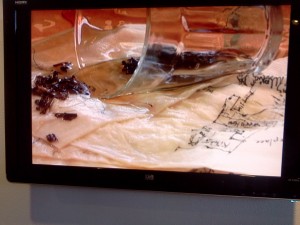
Part II Territorial Trappings
Native American artist Tanis S’eiltin’s exhibition at Seattle Central Community College brought together her Tlingit heritage and contemporary issues relating to intersections of white and Native culture. When Europeans introduced exploitative technology and resource extraction, they were able to subdue and exploit local populations. Indigenous cultures were embedded in capitalist society. They were no longer able to be self-sufficient.
In this new installation, S’eiltin’s theme is Native ties to the fur trade that continued right into her childhood. Fashions such as fur hats made from sea otters, or fur jackets from lynx hides directly benefitted the livelihoods of indigenous peoples, but also impacted their traditional relationships to the natural world. The ambiguity of this economic trade-off is suggested in the gallery with a neon sign reading “Trade” backwards.
Tanis’s father was a good trapper, and he was even said to have wiped out the lynx in Skagway, Alaska. She remembered the furs as part of her subsistence life in her early years (she is now a Professor of Art at Fairhaven College, Bellingham).
In the installation we see memories of skins, re-created on transparent paper that have elusive images of native emblems and tools, hanging from the ceiling.
A real lynx fur and a real trap were part of the installation, their physical reality a stark and crucial contrast to the abstraction of the paper skins.
At the end of the gallery whale baleen sieves hung from the ceiling. In a whale’s mouth, baleens are up to thirty feet long; they have little hairs that collect plankton and food particles. The baleen was used as stays in garments like corsets, another resource extracted from whales.
The main theme of “Territorial Trappings” is that Indigenous peoples participate in practices that plunder resources. There is no absolute dichotomy of holistic native culture and marauding European culture. For over 100 years, native peoples have depended on the income from harvesting and trapping.
At the same time, as the artist told me, in Alaska, life is still based less on consumerism and more in a belief in making do with what you have. Skagway, home to the cruise industry, about which S’eiltin has done another installation, writes that contradiction large. It has a small, fairly impoverished permanent population, but 8000 people invade the city during the cruise season. Certainly the income from those cruises helps people to survive, at the same time that the industry itself represents massive waste of resources and pollution.
This entry was posted on December 20, 2012 and is filed under art criticism, Conceptual Art, Contemporary Art, democracy, Feminism, Feminism, Gazelle Samizay, indians, Iran, Iranian Women, Photography, Women Artists.
“Elles” and Beyond: Women Artists Take on the World
In Paris “Elles” made a big splash and awakened a conversation debate and discussion about feminism. In Seattle we have had a city wide extravaganza of exhibitions of women’s art, symposia, concerts, lectures, performances and special events. It is impossible to assess, though if this really penetrated already held perspectives, changed any minds or even expanded thinking. We have some great creative people here, and some brilliant curators, but the critical discourse and analysis is flaccid. People did get worked up about the marketing of the show that used a photograph of a bikini clad bimbo, and with protesting a ridiculous work by a male artist in which he looked up all the local women artists names he could find and represented them by name with a rows of small outlined breasts. This is an inane response. But it reminds us why we need to give more thought to what these women are saying in their art. The issues they present are still with us.
Less than 20 percent of the Pompidou Center’s “Elles” exhibition crossed the sea, but because the show comes from France, we first of all have a great opportunity to see some extraordinary modern and contemporary art by women working in France and the rest of Europe. For me, it was extremely refreshing to have that emphasis. Finally, an exhibition of women’s art that isn’t based on our “canonical” history ie the Power of Feminist Art coming out of Lost Angeles in the 1970s.
It is not a systematic history, more of a series of unpredictable snapshots. I offer here a look at those snapshots, emphasizing the works that surprised or excited me.
In the very first room a stunning early painting by Sonia Terk-Delaunay jumps off the wall with highly saturated reds, along with examples of her pioneering abstract color painting. Nearby are two woks by the dynamic Russian futurist, Natalia Goncharova, a stage set from the Russian constructivist designer, Alexandra Exter, and a subtle Cubist painting by the less known Marie Blanchard.
While these women often had male partners and collaborators, Suzanne Valadon’s “The Blue Room ” launches defiance. Reclining on a bed with a luscious blue patterned spread (an accomplished homage to Matisse) a tough, real life woman poses in the way of traditional male paintings of nudes, but she is a subject not an object of male desire. With her cigarette in the center of her mouth, she assertively supports herself on one elbow. She wears loose fitting striped pants and her pendulous breasts are covered in a pink top. Valadon’s work speaks of defiance and disgust with male traditions (she herself had been a model and lover of such people as Renoir).
Paris in the 1920s, that hotbed of cross-dressing and sexual freedom by later to be outstandingly famous women and men, comes to us in the photographs of Gisele Freund, Dora Maar, and Berenice Abbott of such celebrities as Virginia Woolf, Vita Sackville West, Sylvia Beach, Nusch Eluard (above), and James Joyce, Jean Cocteau.
Another segment of photographs includes two photographers from that bastion of male domination, the Bauhaus- Lucia Moholy and Florence Henri . Here she is in a self portrait that confronts us with her intelligence and sense of her own strength.
Also not to be missed are paintings by the Surrealist Dorothea Tanning, Czech born Marie Toyen, and, especially, a 1927 experimental film by Germaine Dulac “La Coquille et le Clergyman.”
Jumping forward in time, was another surprise, Marie-Ange Guilleminot’s “Mes Poupees,” a 1993 video of the artist caressing a “doll” made of nylon stockings filled with seeds and covered with talc, a sensuous suggestive sculpture.
Familiar and still formidable work by sculptors like Lee Bontecou, Louise Nevelson and Louise Bourgeois, are followed by a room of abstract paintings, and then what Seattle Art Museum calls “Genital Panic” after a work by Valie Export, in the most provocative room in the exhibition. Export was another surprises for me, a formidable Austrian feminist performance artist. In one famous work called “Action Pants Genital Panic” made in 1969, she walked around movie theaters with the crotch of her pants cut out, thus directly confronting people with a counter narrative to the passivity of women in film. She is way out there.
Also in this room was Hannah Wilke, another bold feminist innovator, who invited people to chew gum which became like vulva which she then stuck on her body and posed in various pin up postures in “Starification Object Series.” Hanging high over our heads on one wall is the wonderful sculpture by Niki de St-Phalle a defiantly enormous woman of junk materials such as hundreds of pieces of dolls and old underwear . In this same room is Sonya Andrade’s “tv” format video of 1975 which is a hilarious and original send up of food shows, as the polite eater starts to throw the food at us ( it is stopped by a glass partition. Sanja Ivekovic, a Croatian artist, continues the theme of cutting the body ( I wondered why Yoko One wasn’t included here) as well as Orlan’s painful surgeries commenting on the cult of beauty.
The second half of the show has fewer surprises, although Atsuko Tanaka’s electric dress jumped out. But it is a reconstruction and should have had at least a photograph of the artist in the 1950s wearing this incredible garment constructed of hundreds of colored light bulbs that followed her nervous and circulatory system.
Particularly timely to see again are Mona Hatoum and Sigalet Landau’s videos, both metaphors of the Palestine Israeli conflict . They both address the body, one on the inside, as endoscopic surgery penetrates orifices, and one on the outside, Sigalet with a barbed wire hula hoop.
This show demands a lot of time ( I barely touched on the videos), and even more time if you immerse yourselves in the third floor, where the permanent collection has been rehung with only women artists, particularly Joan Mitchell, Lee Krasner and Helen Frankenthaler and up to the present with Jenny Holzer and even the very current Ghada Amer.
There is also a stellar collection of early modern artists including Northwest pioneer artists Ella McBride, Maude Kerns, and Imogen Cunningham, as well as two works by Georgia O’Keeffe and Charmion von Wiegand and three of the so called American Abstract Artists of the 1930s.I wrote about both Charmion and the AAA in my book Art and Politics in the 1930s in case you want some context on this period.
The inimitable Sandra Jackson-Dumont brought us Christa Bell performing “1001 Holy Names ” for guess what and she has installed an Adrian Piper work in the Jacob Lawrence Gallery called “Cornered.” It confronts us with our own racism in a particularly effective way. Watch and be cornered. Needless to say, both “Elles”, and SAM have a skimpy representation of women of color.
So it is a delight that , without any question, Yayoi Kusama steals the show on the third floor, (all works on loan from the Gagosian Gallery). Her wriggling erotic forms crawl everywhere on shoes, hats, furniture, walls, floors. She takes the sterility of minimal grids and crosses it with organic shapes that seem to crowd together like an underwater coral. The boat in the show constructed of stuffed work gloves, as well as the snake like yellow and black eruptions on the floor, take over. Her painstaking, obsessive compulsive patterns cover acres of canvas, but the three dimensional forms are much more evocative for me in their physical presence. Kusama lives in a mental hospital in Japan by choice. We should all be so self aware.
From the perspective of global feminism other exhibitions in Seattle took it further. At the Asian Art Museum, women’s paintings from the land of Sita is a dazzling exhibition by artists who formerly decorated houses, and now make paintings on canvas.
That museum is also showing “Touba”, by Iranian Shirin Neshat, the two screen video that takes its title and its “sacred” tree from Tooba and the Meaning of Night by Shahmush Parsipur.
Finally, at the Seattle Asian Art Museum, there are two Chinese artists, Chung Ho Fraenkel, an extraordinary calligrapher, and Lu Wu Ju, an expressionist ink painter.
So where are we so far? Seattle is a city that can be really cosmopolitan. We are fortunate in our curators and their innovative approaches. As far as women artists are concerned to immerse ourselves in these art works is to provoke us to think about women’s place in yesterday’s and today’s world. They are still primarily working within the intellectual confines of the world of culture as artists, but they have more freedom of action. On the other hand, the risk is that with that freedom they are not as compellingly confrontational. Looking at Pipilotti Rist’s videos, I was left completely flat, compared to the work of say Martha Rosler, Eleanor Antin, or Ana Mendieta. Her work seems cliched and decorative. Today’s world has a myriad of really important women’s issues that could be addressed by artists if they chose.
More to come.
This entry was posted on November 25, 2012 and is filed under Art and Activism, art criticism, Contemporary Art, Feminism, Iranian Women, Israel Palestine, Sandra Jackson-Dumont, Seattle Art, Seattle Art Museum, Shirin Neshat, Uncategorized.
Sonic Time: Speech Sound Silence at the National Museum of Contemporary Art in Athens
While the protests were raging in the streets in Athens, the National Museum of Contemporary Art was holding a retrospective from its permanent collection of cerebral conceptual art since the late 1960s. It was beautifully curated by Ana Kafetsi.( you can see all the images on the website, as well as detailed explanations. Ypu can see more of my Cycladic pictures on Art and Politics Now Flikr site)
Since I arrived in Athens after the protests ended (all I saw was a Susan Komen race for the cure), and I had just spent 10 days on a remote Greek Island, I decided it was time for an injection of contemporary art.
At first I thought oh dear how can I possibly be interested in this, but then I surrendered to the John Cage work, lay on the floor for 30 minutes of blissful emptiness listening to his extraordinary composition and watching light and dark patterns changing in the room, and I left with a new feeling of receptiveness to conceptual art. The 1992 Cage piece is very long, a total of 94 minutes, I heard just a part. Opus One 11 is a “Film without subject.” Of 103, Cage writes: “103 is an orchestral work. It is divided into seventeen parts. The lengths of the seventeen parts are the same for all the strings and the percussion. The woodwinds and the brass follow another plan… Following chance operations, the number of wind instruments changes for each of the seventeen parts.” At any rate it was beautiful in its randomness with an underlying sense of classicism.
After observing sunrises and sunsets, experiencing the burning midday sun and the rapid descent of darkness in Greece, I was really tuned into light and random experiences. Light is really what Greece is about in an aesthetic sense and random is what life is like if we give it a chance.
So then I went back to three early works, Sol Le Witt’s Sentences on Conceptual Art( 1969), John Baldessari singing Le Witt’s sentences to popular tunes ( 1972), and Lawrence Weiner’s Declaration of Intent from 1969. Le Witt’s sentences are still resonant today and many artists would benefit from thinking about them. So here are these three “old masters” of conceptual art in the Greek National Museum, as protests against austerity rage in the country.
Let us think about that. For example, these artists were fed up with capitalism, they were looking for the underlying structure and purpose of art outside the physical aesthetic object. The protesters are also fed up with capitalism and its dictates. They want the underlying significance of the state to survive, that is the obvious idea that the government is meant to provide certain basic supports for its citizens ( of course in the US that idea has been entirely thrown out- the government here is intended to be privatized). What the conceptual artists and the Greek protesters share is disgust with the corruption of capitalism and its corrosive effect on the spirit.
In his 1969 work. Weiner is really young, bearded, lanky. He is wading into a storm tossed sea to get random pieces of driftwood ( drift logs I should say) that can or cannot be made into a sculpture if desired. It is a lovely open ended statement – “I don’t care about the thing, I care about the act and the act is determined by wind, sea, rain, water, and my own strength or ingenuity in lifting these logs.” ( that is a pseudo quote)
Gary Hill was well represented in the exhibition with many many pieces, a virtual mini retrospective of Gary Hill. One of the most intriguing was a piece called Thomas the Obsucre based on a book of that name from 1987, in which Hill is telling a story ( sort of). Looking at this piece, it was easy to see why he gave up on that direction and turned to the components of video, light, movement, space, sound, and psychological experiences.
The exhibition included many major Greek contemporary artists, for example, there was Bia Davou, with tiny drawings with Greek letters on graph paper called Serial Structures:Odyssey,
and Chryssa with an amazing Cycladic book from 1957.
Having just come from the Cyclades, it was easy to connect to this all white piece. There were other less well known Greek artists, that I enjoyed seeing, particularly the 2012 sound and video installation with a surprise ending by Makis Faros that suggests a collapse of expectations.
The intersections of Greek art and historical conceptual art was revealing,- sound and light are both basic components of the Greek environment. and naturally of Greek art.
The high point of the show for me was the accidental overlap and juxtaposition of two pieces. The first was by Bruce Nauman, Playing a Note on a Violin While I walk Around the Studio, from 1967 – 68.
Right next to his piece (so close that his violin could be heard) was another piece by Danae Statou called Ice Songs 2. These were the sounds of icebergs in the Antarctic forming, colliding, squeezing together, going into the open sea. The source of the sounds was a result of scientists monitoring the break up of Antarctica with water microphones on the sea bed of a defunct US naval base They were formerly part of a massive monitoring effect to track Soviet submarines. She collaborated with Vassilis Koutouris on imagery to accompany the sounds. Changing waves of blue and white projected on the floor of a large gallery floor provided accents to the changing sounds of the ice bergs. So here was juxtaposed a violin note ( actually two close together) by an artist rejecting aesthetics and consumption, and an accidental sound “concert” by ice bergs cracking up (of course related to our warming planet).
But in contrast to the 1960s artists who offered an escape from the clutter and corruption of the world, this piece is calling attention to the disintegration of the world. The piece intentionally has meaning beyond the sound itself. It is telling us of the invisibile and powerful forces at work all the time.
If we don’t actually pay attention to these particular random sounds and what they signify, we are looking at an end of the world, a forecast of which we had this week with the Super Storm Sandy, itself a coming together of various powerful forces and fronts. Global climate change is with us. The extraordinary power of nature is going to win the day in the end. That is getting more evident every day. The conceptualist artists definitely had the right idea about rejecting capitalism and the “art” world and embracing nature on its own terms.
This entry was posted on October 31, 2012 and is filed under Contemporary Art.
Negar Farajiani Puzzles of Meanings
In Seattle at the M.I.A. gallery, we have the treat of an exhibition of work by Negar Farajani until November 16. Negar is from Tehran, Iran. I had the opportunity to talk with her about her art work and life in Iran. Negar is part of a group of young artists in many media who are based in Tehran. In addition to her own art, she also curates exhibitions and organizes projects with other artists.
I met Negar Farajani in the M.I.A. gallery, a sliver of a gallery in a downtown space run by the sophisticated Mariane Lenhardt, recently moved here from Paris, with roots in Somalia. We plunged right into a stimulating discussion about modernism in Africa. But that had to wait for another day to be completed as my main focus was to learn about Negar’s art in the gallery and life for artists in Iran.
Negar was born in Yazd, one of the oldest city’s in Iran. Yazd is in the center of Iran, a spectacular city in the midst of deserts (formerly an oasis), with historical architecture, crafts traditions, and Zoroastrian shrine. She went to art school there. Negar now lives in Tehran with her husband, who is a musician; he plays the “tar”, a predecessor of the guitar. He also composes music for films. They have a four year old son.
The exhibition in Seattle consists of intersecting works, based on the same format, the jigsaw puzzle. The artist cut the jigsaw pieces from dry mounted photographs of things in her life such as her son’s teddy bear, an ipod, a toy car or elephant, then reassembled the images by mixing and matching (all of the jigsaw puzzles are identical in their cuts).
The result is a provocative suggestion of the intersections of cultures and the complexity of life. Inserting some unidentifiable object into a teddy bear and calling it terminator is an idea that can be understood anywhere.
The most identifiable group consists of a reference to a trial: the accuser, the attorney, the witness, ( see above) and the executioner.
It was not clear if each layer had a specific reference or metaphor, but the overall effect is that reality and truth are elusive and sometimes frightening.
But Negar emphasized that people in Iran were leading ordinary lives. She was wearing a pink knit sweater and softer colored pink scarf hung around her neck. When I asked her, as no doubt everyone does, if she had to cover herself in black in Tehran, she said no, she could just toss this scarf over her head. So that suggests, at least for the privileged urban elite, the patrolling of women’s head coverings is in abeyance at the moment.
The artist explained to me that In Iran people often speak wordlessly with their eyes and indeed the eyes in these works were huge and expressive. But her main message was the idea of making a cultural bridge between cultures. She is hopeful that she can be a part of world peace.
This exhibition is just one fragment of Negar’s work, adapted for travel. On her website you can see the full range of her installations and projects, in many different media. One of her works is about an old spinning wool factory in Yazd now abandoned. Several artists created installations there, and Negar’s piece is a very large plastic beach ball ( “Made in China”) that is rolled around the space. Another work is called Tehran Monoxide, photographed many of her friends with children. The theme is the bad air in Tehran and how difficult it is for children to play outside, but what you see in the project is one young family after another, enjoying their small children. Such a simple set of images immediately gives us a much needed glimpse of real people living their lives.
It was delightful to meet her, and indeed, a small encounter like this with one person from Iran makes such a difference. I went home from meeting Negar and was immediately plunged into the Presidential Debate and its endless repetition about preventing Iran from getting a nuclear bomb and increasing sanctions. We have such a narrow view of the world in the US! Culture is indeed a great bridge and a peacemaker. We are all connected by creativity. That is what makes us human on a shared planet.
This entry was posted on October 25, 2012 and is filed under Contemporary Art, Uncategorized.
“Living as Form” and the Hemispheric Institute: Two approaches to art and politics
Creative Time Summits (here is the schedule of the upcoming Summit) are a primary place for the discussion of socially engaged artistic practices. Laurie Jo Reynolds (above) is one artist who has been featured several times for her important work, moving from an artist working with prisoners at Tamms Supermax Prison, to a political activist for prison reform.
Throughout Living as Form, edited by Nato Thompson, a book based largely on last year’s Creative Time Summit, artists who take on political and social issues in the public sphere, are celebrated. But the (exciting) transitions currently emerging in the critical discussion of this formerly discredited practice are evident. There is a pervading anxiety about and sometimes dismissal of concepts such as ‘relational aesthetics’, ‘social aesthetics’, ‘social practice’, ‘tactical media’, ‘dialogic art’, and ‘new genre public art’. Since the 1990s these terms have been the standard vocabulary for analysing public practice art.
This anxiety reminds us that, in fact, immediately after this book was published, in the fall of 2011, and even as the Forum it was based on was taking place, the Occupy movement in Wall Street and the City of London as well as elsewhere around the world, burst through traditional patterns of protest. It had complex roots in various ideologies, including anarchism, Socialism, pacifism, anti-capitalism, and many others. In New York there was a direct connection to resistance in Greece and Spain. It became a worldwide embodiment of living as protest. As both an aesthetic and political statement in public space, it has forced a new and multifaceted analysis of the constantly changing relationship of art and politics, particularly in the public sphere.
Nato Thompson, as chief curator at Creative Time, presciently adopted what he calls the ‘cattle call’ method in his introduction, which includes projects initiated by both artists and non-artists. He suggests that non-profit organizations themselves can be ‘artworks’. This idea is both provocative and timely. Unfortunately, the cattle call also extends to his enumeration of political and social crises, which he lumps into a single paragraph, as well as to the all-too-brief discussions of artists and projects.
One critic who interviewed Thompson on his thesis that NGOS, street protest and performance art are all equal was Barbara Pollack
Other authors in the book, and participants in the forum include theorist Clare Bishop, who sets up a relationship between the ‘social discourse’ and the ‘artistic discourse’ that can be ‘unseated’ by participatory art works. Maria Lind, a curator, emphasizes projects that include people in social and political change, while Carol Becker offers ‘microtopia’ or small solutions to big problems. Brian Holmes, a philosopher involved with the international social justice movement, and Shannon Jackson, director of the Arts Research Center at University of California, Berkeley, emphasize the 1930s Federal Theater Project as a precedent for political art in the community.
By far the most radical essay, though, is by Teddy Cruz, trained in architecture and design, and a dynamic thinker who up-ends these issues by placing the real world at the forefront. He begins with an eloquent critique of our current state: ‘a critical juncture in history, defined by unprecedented socio-economic, political and environmental crises across any imaginable register’. For him, ‘our institutions… have atrophied’. His refreshing analysis of the relationship of art and economics concludes with the idea that marginal communities of immigrants are the real sites of creative thinking.
The rest of the book is an alphabetical listing of just over 100 artists, groups, and projects in public spaces that engage with a range of issues. The book is a valuable point of departure for its subject, although the elite cultural position of the authors limits its scope. Certain topics are popular here (those relating to urban renewal or alternative economics, for example), and other areas are barely covered, such as immigration (there is no reference to the border art of the last 50 years).
Equally exciting is Diana Taylor of the Hemispheric Institute of Performance and Politics (stunning website!) “working at the intersections of scholarship, artistic practice and political life in the Americas.” The Hemispheric Institute has an a Digital Video Library with 600 videos on line of socially engaged performance art in the Americas over the last thirty years. As Diana Taylor put it, “As long as human beings can make room for imagination, they can be artists.”
She askes “how do resistance strategies travel?
The Institute is also “a network of interdisciplinary and multilingual artists academics, and activists in the Americas. It creates collaborations that explore emboddied practice -performance -as a means for the creation of new meanings and the transmission of cultural values, memory and identity.” It operates in multiple countries and languages.
One of its current activities is to provide space for the Yes Lab, an opportunity for the Yes Men to interact with Occupy activists to create effective interventions in the political and public arena.
Diana Taylor agrees with the idea that embodied public poltiical activism is equallysignficant as self designated artists who create public art works. She is also erasing any distinction between art and activism, between the world and aesthetics.
Creative Time and the Hemispheric Institute are only a few blocks apart in NYC. Perhaps they have spoken with each other. I hope so.
This entry was posted on September 15, 2012 and is filed under #Occupy movement, Art and Activism, Art and Politics Now.

